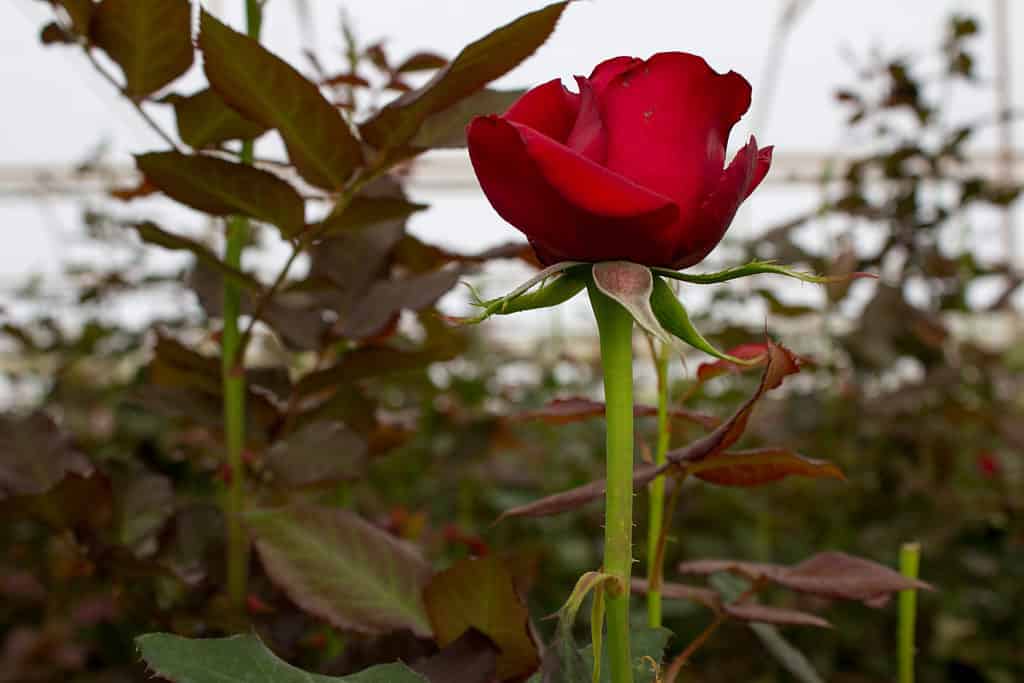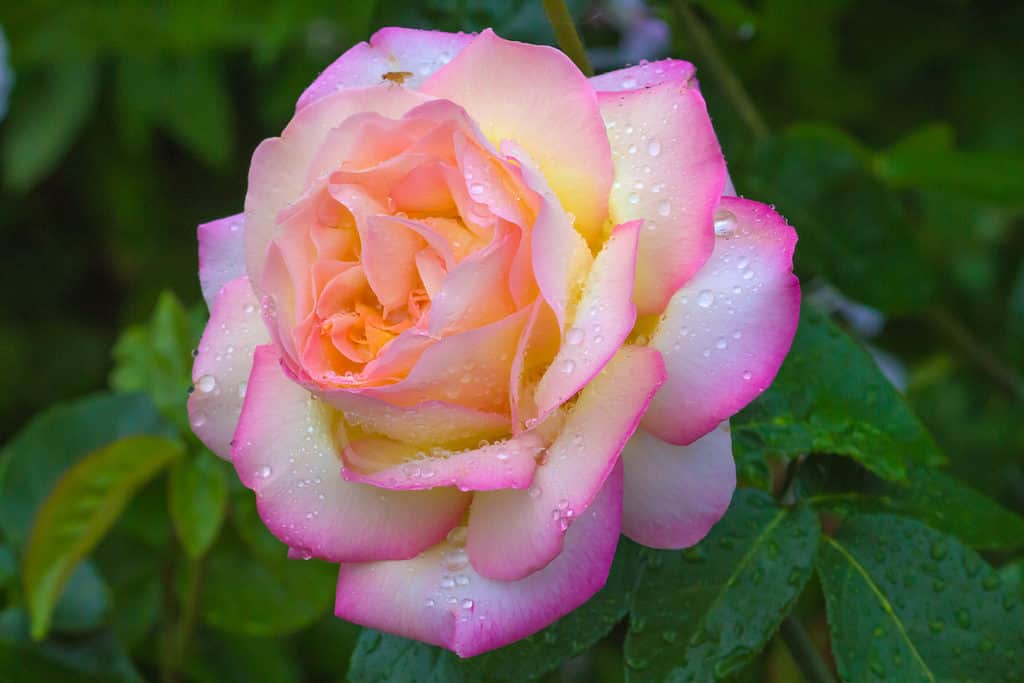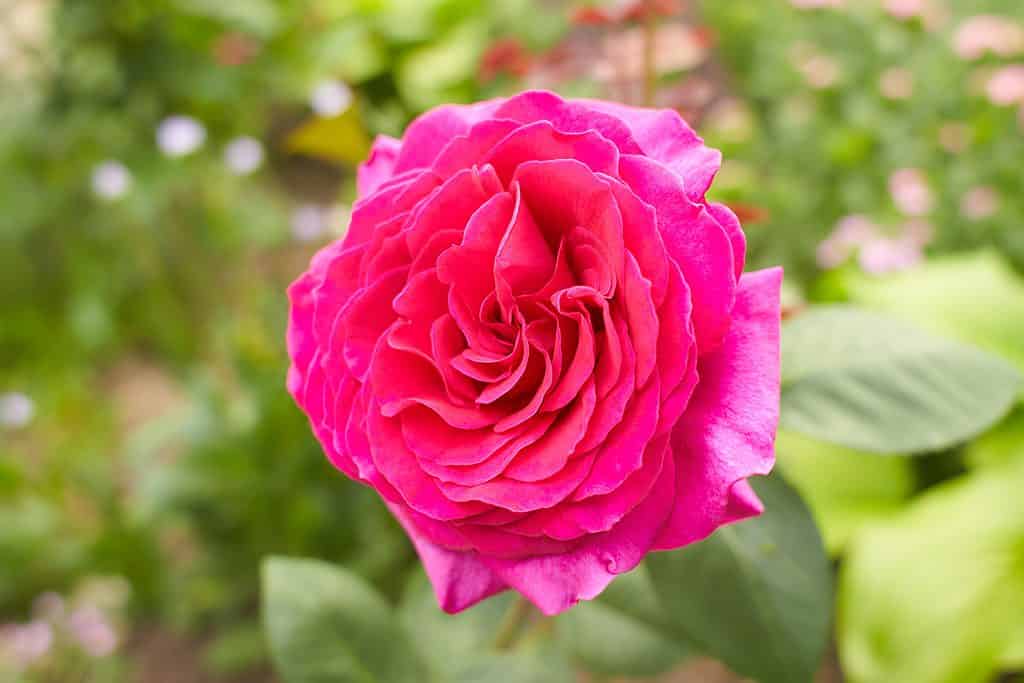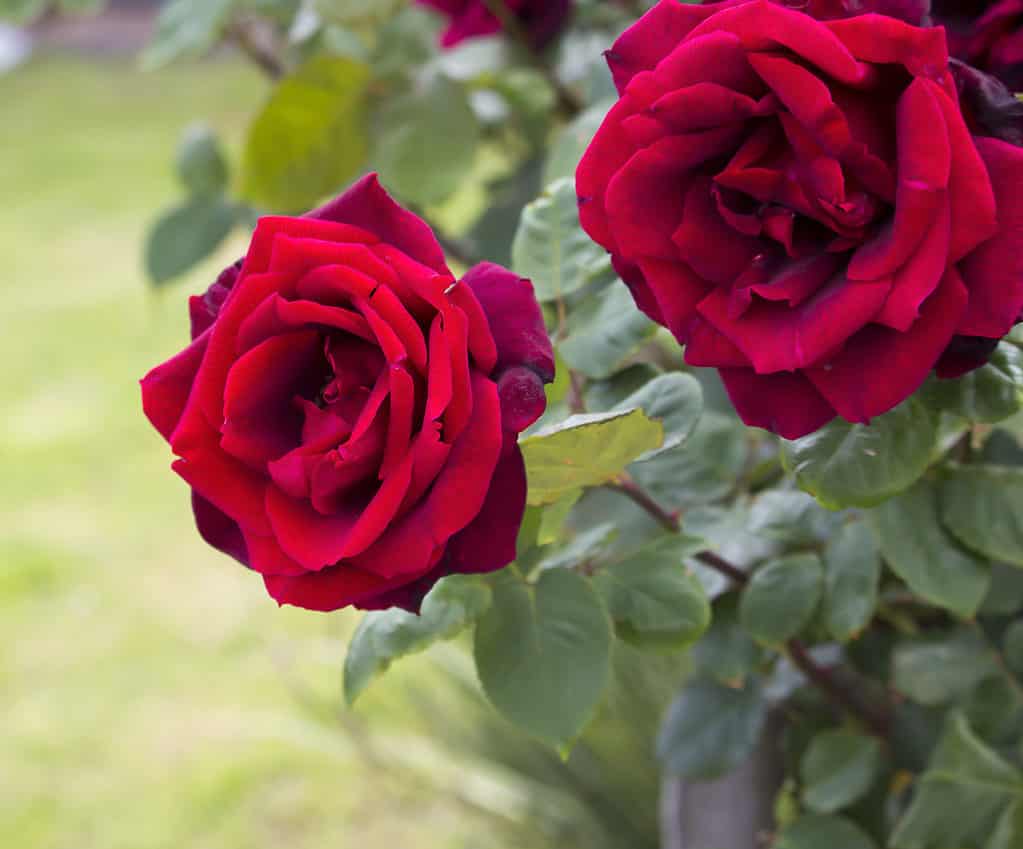Perhaps the best way to describe growing long-stem roses is to mix in a basketball metaphor. Many gardening practices are easy layups. Take succulents, for example. Most succulents require very minimal care. Plant them. Do next to nothing after that. And they still thrive. It’s an easy layup!
But then other gardening practices are more akin to hitting a three-point jump shot from way downtown. Growing long-stem roses certainly belongs in this category. Like a long three-pointer, it’s a much more difficult shot but also so much more rewarding when you nail it.
If you’re ready to lace up your sneakers and hit the court, then let’s go! Here are some tips to give you the best possible chance of draining that shot from behind the arc.

Growing long-stem roses is a more difficult shot, but that shouldn’t stop you from shooting!
©TandemBranding/Shutterstock.com
Why Is It Difficult?
Long-stem roses are among the most common flowers in bouquets and cut flower arrangements. They are readily available at floral retailers practically anytime. So why is it so difficult to grow them? First, we must remember that professional rosarians have resources that most residential gardeners lack.
First of all, they grow their roses in greenhouses. This allows growers to manage the climate perfectly. They can keep the temperature in the optimal range of 70-80°F and maintain a humidity level of 60-70%. The greenhouses also allow the pros to increase carbon dioxide levels. This de-stresses the plants and increases their ability to take in water.
These greenhouse roses grow in an environment that increases their photosynthesis, which accelerates the growth of the roots and allows the plant to absorb more nutrients.
Now we’re beginning to see why it’s such a challenge for even the most experienced recreational gardeners to grow long-stem roses that can compete with professionally-grown flowers. But some of us like a challenge! If that’s you, keep reading.

Commercial roses are almost always grown in greenhouses.
©nataliaec/Shutterstock.com
How to Grow Long-Stem Roses
Choose the Rose Variety
It begins by choosing a rose variety that normally grows a longer stem. The hybrid tea rose is the standard for long-stem roses. The long sturdy canes and stems combined with the large, classically-formed blooms make the hybrid tea rose the premier choice for growing long-stem roses.
The hybrid tea rose’s bloom color often displays the iconic rose red we all know and love, but there are also pink, white, yellow, orange, green, and purple varieties.
It’s best to purchase your roses as small plants from a local gardening center. Attempting to propagate quality long-stem roses from stem cuttings is adding a challenge upon a challenge. If you want to give it a go, then have at it! But it will be an uphill climb all the way.
Remember, we’re not just talking about growing roses. Stem cuttings are a great way to propagate rose plants. But in this article, we’re talking about high-quality, long-stem roses. Gardeners will need to give themselves every possible advantage, which includes starting with small plants instead of stem-cutting propagation.

Hybrid tea roses come in an array of colors, like this vibrant orange-pink-white flower.
©Alex Kinval/Shutterstock.com
Pruning
Growing long-stem roses requires fastidious pruning. Remove all buds except the main one. This will allow the plant to funnel all the nutrients it absorbs to that single bud, resulting in a larger bloom.
All lateral leaves and supporting branches must be pruned, as well. Be careful not to damage the stem, though! Remove any bloomed roses before the hips form.

Long-stem roses require careful pruning.
©photowind/Shutterstock.com
Soil
Roses generally should be planted in mid to late spring, although the exact timing will depend on the plant hardiness zone where you reside.
Roses need loamy soil to reach their full potential. If the soil has too much clay, it will hold excess moisture, and the roots will become waterlogged. On the other hand, if the soil is sandy, it will likely drain too quickly, and the roses will be deprived of needed water.
Select a highly-quality fertilizer that is rose-specific at planting. Fertilize your roses twice a year after that.
If you really want to increase your odds of growing high-quality long-stem roses, you can use a soil sample kit to test your soil. Take a soil sample to your local extension office where they can analyze it. These experts can give you a full report on your soil quality, showing what is adequate and what amendments are needed.
When planting your roses, dig to a depth of around two feet. Space the plants about three feet apart. Add a few inches of mulch around each plant. This deters weeds and keeps the roots cool. It will also help the soil retain moisture. Organic mulch gives roses an added boost. As it breaks down, it will release additional nutrients into the soil. Quality compost, shredded bark, and leaf mold all work well.

This lovely hybrid tea rose reminds us why they’re always in high demand.
©Diane N. Ennis/Shutterstock.com
Climate
This is where it gets tough. You can control your roses’ pruning, soil quality, and fertilization, but the weather conditions are out of your hands. As with any challenging undertaking, though, you simply control what you can control. Here are a few ways you can tip the scales in your favor.
Choose a spot that receives six hours of sun a day but is also shaded from direct sun in mid-afternoon. If roses don’t receive enough sunlight, they will not flourish. But, too much direct afternoon sun can stress the plant.
Roses also need consistent moisture. Plan to water your roses every couple of days, depending on the conditions. If the soil seems to be dry, the plant needs a drink. Roses require a minimum of three inches of water per week to reach their peak potential.
Roses grow best in Zones 5-8. If you live outside of these zones, growing long-stem roses isn’t just a long three-point shot. It’s a half-court Hail Mary! Yes, you can (and should) grow lovely roses outside of these four zones. But if you want to grow long-stem roses that rival what you can buy from your local florist, colder or warmer zones just won’t allow for that.

Hybrid tea roses need six hours of sunlight each day.
©Irene Fox/Shutterstock.com
Pests
Roses are particularly susceptible to aphids. Their presence is often made known by their sticky excretion, known as honeydew. Another telltale sign of an aphid infestation is a large presence of ants. Ants and aphids have a symbiotic relationship. The ants feed on the aphids’ honeydew excretion, and the ants protect the aphids in return.
Spider mites can also be problematic pests. These arachnids are often found on the underside of the leaves.
Thrips, Japanese beetles, and caterpillars are also a threat to roses.
If infestations are small, you can try washing the pests away with water or simply removing them by hand. But for larger infestations, you’ll want to take more aggressive action.
Insecticidal soap can be quite effective in eliminating infestations of soft-bodied insects such as aphids, mites, and thrips. Beetles and caterpillars are normally immune to its effects, though. Neem oil is generally effective against the majority of rose pests, including caterpillars and beetle.
Neem oil and insecticidal soap are both natural defenses against pests. Synthetic pesticides are also an option, but they carry additional environmental and personal risks.

Unfortunately, aphids love roses almost as much as we do.
©Floki/Shutterstock.com
Give It a Go (And Give Yourself Some Grace)
Now that you’re armed with some basic knowledge and tips, you can get moving with your plans to grow long-stem roses. But remember, no matter how much knowledge you’ve acquired, your first attempt is probably going to be more of a learning experience than one that produces a bumper crop of long-stem roses. Give yourself permission to struggle or even fail. Learn, adjust, and try again.
There is a reason that long-stem roses cost so much at the florist. Cultivating these flowers is extensive and time-consuming. These flowers are also commercially expensive because these retailers are normally the only places where you can find quality long-stem roses. Supply and demand drive up the price even further.
If you’re ready to say “No!” to these high-priced flowers and grow your own long-stem roses, then it’s time to get started. With patience, education, adjustments, and good old-fashioned stick-to-itiveness, you might just sink that long-range jump shot!

Ready to grow your own long-stem roses? Take the shot!
©alybaba/Shutterstock.com
The photo featured at the top of this post is © Salad Days/Shutterstock.com
Thank you for reading! Have some feedback for us? Contact the AZ Animals editorial team.






